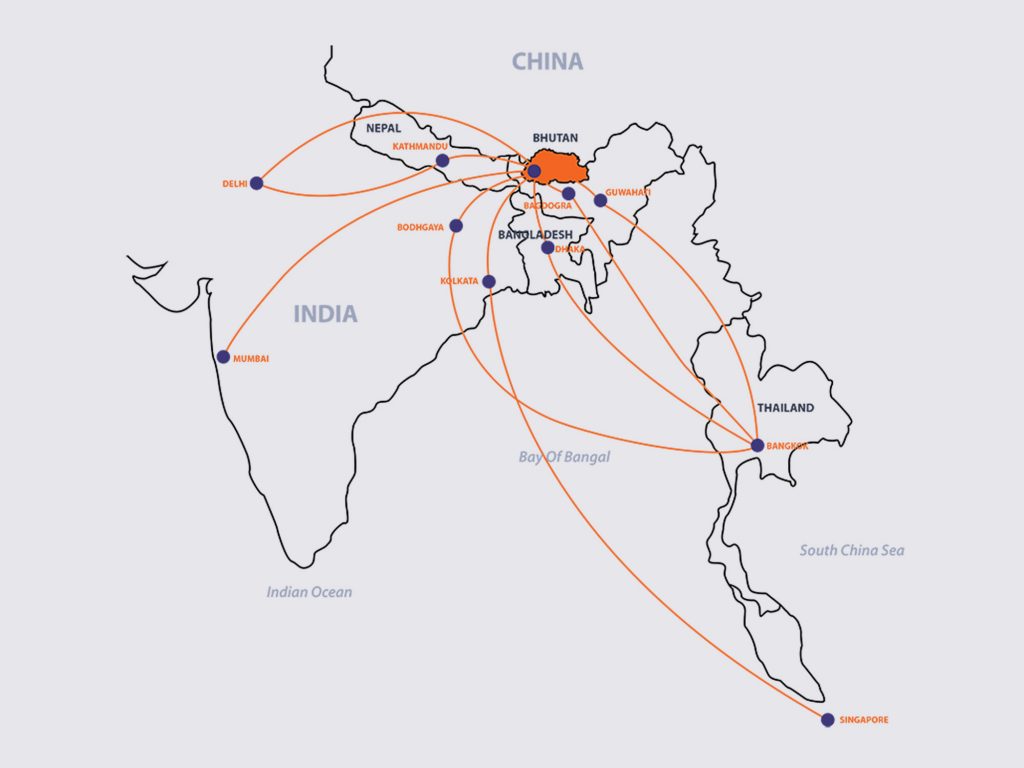The Kingdom of Bhutan is a tranquil country where you can explore the ancient cultures, beautiful landscapes and magnificent architecture.
Bhutan, called Druk Yul by its people, is known as the “Land of the Thunder Dragon”. It is one of the world’s most beautiful, yet mysterious places. It is located on the eastern edge of the Himalayan Mountain region. A large part of the area is forested welcoming a diverse ecosystem of flora and fauna. The country stretches from subtropical valleys and plains to snowcapped mountain ranges. This landscape makes it the perfect place to trek through the majestic valleys or steep mountains to visit ancient architecture and Buddhist temples.
Bhutan has a rich culture where most of its 700,000 inhabitants practice the Buddhist religion. This secluded land has a rich history embedded into the society and shows through the festival reenactments. Bhutan’s ancient cultural traditions have continued to grow despite the current technological restructuring. Only since the mid 1970’s technology has come to Bhutan. It has become the ultimate tourist destination for adventurers, spiritual awakenings, and serene visages.

HOW TO GET TO BHUTAN
Drukair, The Royal Bhutan Airlines has flights that enter through the illustrious Paro Valley. The airline operates out of nine cities in six countries. No matter where you are in the world, Drukair will get you to the most peaceful place on Earth. Representatives can help you schedule the best way to fly to Bhutan. Expect expert service and care when you fly Drukair.
Flights from Bangkok, Thailand and Kathmandu, Nepal have daily arrivals. Other flights use Singapore, Dhaka, Bangladesh, Sydney, Australia, and Kolkata, Bagdogra, and Gaya, India.
HIGH VALUE – LOW VOLUME TOURISM
A high volume of tourism may seem like a good thing for Bhutan’s economy, but for the Bhutanese, protecting their culture and environment is most important. Bhutan’s Royal Government used to limit the number of tourists entering the country. Officials believed that unrestricted access to the country would have a negative impact on the natural environment and ancient cultural traditions. This belief led to the notion of “High Value, Low Volume” tourism. Tourism, like all Bhutanese industries must be sustainable and environmentally friendly.
The government wanted tourists to understand the feel the deep-rooted culture and traditions, so they would have a higher appreciation for their surroundings.
Tourism has become the second highest economical contributions to the Bhutan economy, after the agricultural industry. Recently, the government decided to increase the tourism rate. The Tourism Council of Bhutan extended the tourism areas to include once protected communities, natural reserves, and ancient cultures.
GROSS NATIONAL HAPPINESS
Bhutan is known famously as the first country in the world to measure progress based on happiness. To do so, the 4th Druk Gyalpo coined the term Gross National Happiness (GNH). From then on, GNH was used to measure the country’s development instead of Gross National Product (GNP).
The happiness of the Bhutanese is more important than material growth and there should be a balance between to two. A GNH Commission was created to take an annual measure of how the people fare. The poll is based on an index of nine domains. Living standards, education, health, cultural diversity and resilience, community vitality, time use, psychological wellbeing, ecological diversity, and good governess are the nine domains that are taken into account. According to the GNH Commission, 81.5% of the population of Bhutan is deeply happy. The Commission is still working on ways to achieve total happiness for 100% of Bhutanese.